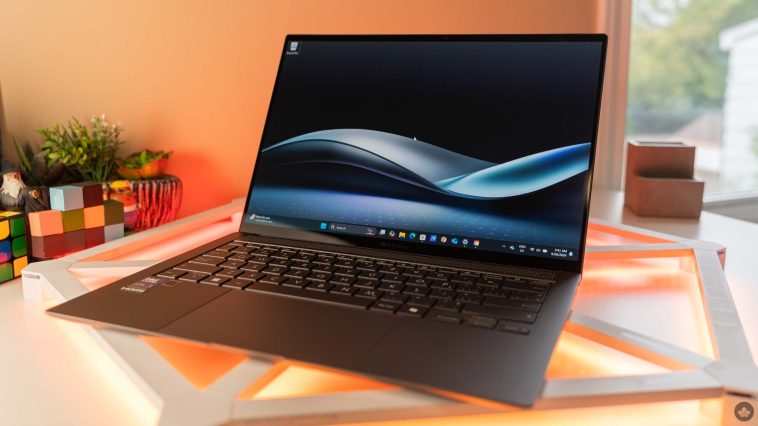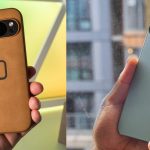The first time I picked up the Zenbook S14 (2024), I was struck by the thinness. It’s easily one of the thinnest laptops I’ve ever used, and that’s saying something after I spent the last few months trying various ultra-thin laptops boasting ARM chips. And it’s even more impressive that a laptop that thin sports Intel’s Lunar Lake Core Ultra 7 chip.
When I finished marvelling at how thin it was, my next thought was battery life. As much as I love a thin laptop, it’s pointless if it can’t make it through a day of work. Historically, Intel-equipped laptops have struggled in that department, and the Snapdragon X Elite laptops I’ve been using recently, like the HP OmniBook I reviewed, made it through my workday handily.
Intel promised better battery life from Lunar Lake, but does it deliver? Should Asus have made the Zenbook S 14 a tad thicker to incorporate some extra battery life? What the hell is ‘ceraluminum?’ Read on for the answers.
Specs
Display: 14-inch 2880×1800 pixel OLED 120Hz 500nits peak brightness
Processor: Intel Core Ultra 7 258V
Memory: 32GB
Storage: 1TB
Dimensions: 31.03 x 21.47 x 1.19 ~ 1.29 cm
Weight: 1.20 kg (2.65 lbs)
Camera: FHD webcam with IR for Windows Hello
Operating System: Windows 11
Battery: 72Wh
Connectivity: Wi-Fi 7, Bluetooth 5.4
Ports: 1x USB 3.2 Gen 2 Type-A, 2x Thunderbolt 4, 1x HDMI 2.1, 1x 3.5mm audio
Graphics: Intel Arc
Note: the above specs are for the specific configuration I tested. You can find all the spec options here.
Certainly ceraluminum
The Zenbook S 14’s lid features what Asus calls ceraluminum, a combination of ceramic and aluminum that’s stronger and more resistant to wear. I’ve had the laptop for a few months, and it’s been my daily driver for a good chunk of that time, which means I’ve worked on it in nearly every room in my home as well as trundled it back and forth from Hamilton to the MobileSyrup office in Toronto several times. At this point, I’m confident the ceraluminum can withstand most abuse from typical use – my S 14 doesn’t have a single scratch or scuff on it. However, it has accrued significant smudges from my fingers, and I find they don’t wipe away as easily as on other materials.
Still, for the premium feel and look and the added durability, I’d say it’s a win overall. My only real quibble is that Asus only used ceraluminum on the lid of the S 14, making it more of an accent than anything. However, Asus has addressed that with more recent laptops, like the Asus Zenbook A14 (stay tuned for a review of that coming soon).
Despite that, the S 14 is ultimately very premium. Thanks to the thinness and silver-toned etched Asus logo on the lid, it looks fantastic. And that carries through even when you open the laptop and see that 120Hz OLED panel. The display looks sharp, has great colours, and everything I do on it feels buttery smooth. Unfortunately, as I’ve found with many of the laptops I’ve tested recently, 120Hz absolutely kills battery life (even with the dynamic refresh rate option on the S 14), so I kept it locked at 60Hz.
Performance as promised?
The Intel Core Ultra 7 258V featured in the Zenbook S 14 is pretty solid overall but doesn’t quite live up to the promises in my testing. The S 14 handled everything I threw at it, with my typical workload including tons of web browsing for researching and writing, editing pictures and more. Photoshop worked great, and even with tons of tabs open, web browsing remained fairly smooth across most browsers I tried, including Edge, Firefox and Vivaldi. I think the 32GB of RAM was a big help in that regard.
Overall, I don’t have any significant complaints with the performance on display here. In benchmarks, things mostly line up as I expected, though I was a bit surprised to see the chip come in slightly lower on the Geekbench 6 CPU multi-core score than what I’ve seen on laptops sporting Qualcomm’s Snapdragon X Elite.
You can check out the scores below, which were tested while the S14 was plugged in and set to the best performance mode. Performance can vary when unplugged or set to other power modes. It’s worth noting here that Windows 11 now helpfully has separate power mode settings depending on whether your device is plugged in. This means I can set it for best performance when on the charger and best efficiency when unplugged to eke out a little more battery life. I also found the S 14 didn’t score significantly better than older Intel chips – for example, the Zenbook 14 OLED I reviewed in December 2023 sported an Intel Core Ultra 7 155H chip and put up fairly similar results.
Speaking of battery life, the S 14 isn’t bad, but it barely makes it through my typical eight-hour workday. More often than not, I was scrambling to plug in during the final hour of my day. It makes it tough to recommend the Intel-equipped laptops over the Snapdragon options unless you need apps that won’t run well on ARM chips, especially with the chips offering near parity on performance while the Snapdragon ones are much more efficient and thus offer longer battery life.
Everything else
Pretty much everything else with this laptop can be summed up as “fine” or “good.”
The keyboard is good. It’s not my favourite typing experience, but it’s definitely not the worst I’ve ever used. The keys have decent travel, but they lack tactility. I prefer my keyboard to have a clicky feel, but the Z 14 only sounds clicky.
I’d also like to see Asus move the power button out of the keyboard or at least move it further away from the delete key. On more than one occasion, I accidentally hit the power button instead of delete, which was definitely a bit frustrating. Plus, the Asus logo sitting just above the top-right corner of the keyboard would be a prime option for a power button.
The touchpad is overall pretty solid. It’s a nice size, big enough that it doesn’t hinder me at all when I’m working away from my desk. It feels smooth and responsive, which is great. Asus highlighted some gesture features of the touchpad, which allow you to adjust the brightness or volume by swiping on the right and left edges of the trackpad, respectively. Interestingly, swiping along the top edge is a more contextual control, allowing you to scrub through videos or scroll your cursor through text.
When I first heard about these features, I expected I’d disable them quickly because there was no way they wouldn’t get in the way of using the touchpad. But by the time I got the laptop, I had forgotten about them until I settled down to write the review. I was surprised to discover the gestures had been enabled on my S 14 the whole time, which is a testament to the fact that they won’t interfere with regular touchpad use. It’s also indicative that the smart gestures are a tad redundant – there are buttons on the keyboard that already handle much of the same functionality, after all – but hey, the gestures are there if you want them, and they won’t get in the way if you don’t.
The speakers are fine, nothing really exciting but they get the job done. Likewise, the webcam is fine but nothing to get excited over. It’ll serve for video meetings, and that’s all it really needs to do.
Finally, like most Windows laptops, the S 14 heavily features AI in its marketing but I have still yet to find a single compelling use case. People keep hyping AI and telling me about how they do so much with it, and every time I try it, I end up spending more time on the task because AI screws it up and gets it wrong.
Worth the price?
The Zenbook S 14 is a premium laptop, and, unsurprisingly, it comes with a premium price tag. It starts at $1,799.99 in Canada for the Core Ultra 5 226V with 16GB RAM version, but it goes up $400 for the Ultra 7 258V with 32GB RAM, for a total of $2,199.
The prices are roughly in line with those of similarly specced Windows laptops I looked at, with one of the biggest differentiators being the OLED display. So, if you’re interested in OLED, then the S 14 does have a bit of a value play in that regard since, for the same money as similar laptops, you’re getting that OLED.
The S 14 is ultimately a premium option, which means paying top dollar. While there’s nothing wrong with splurging on a high-end laptop like this, anyone looking to stretch their dollar further can find better value options.
The Zenbook S 14 is available from Asus, Best Buy, and Amazon Canada (though Amazon’s price was slightly higher at the time of writing).
MobileSyrup may earn a commission from purchases made via our links, which helps fund the journalism we provide free on our website. These links do not influence our editorial content. Support us here.





GIPHY App Key not set. Please check settings